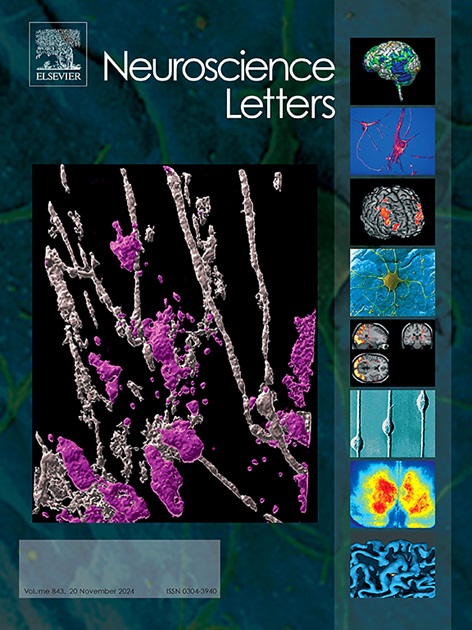Inhibition of the nucleus accumbens core with DREADDs after acute and repeated exposure to oxycodone reduces locomotor activity in female but not male Rattus norvegicus
IF 2.5
4区 医学
Q3 NEUROSCIENCES
引用次数: 0
Abstract
Opioid use disorder affects both men and women, but significant sex differences exist in addiction vulnerability and progression. The nucleus accumbens (NAc) plays a critical role in drug reward and motor outputs, yet its sex-specific functions in opioid response remain poorly understood. We investigated the role of the NAc in acute and repeated oxycodone response using chemogenetics in male and female Sprague Dawley rats. Inhibitory DREADDs (hM4D(Gi)) or control vectors were injected into the NAc core. Rats received oxycodone (1 mg/kg, i.p.) or saline for 5 consecutive days with locomotor activity monitoring. Following a 7-day drug-free period, all rats received oxycodone challenge (1 mg/kg, i.p.) with clozapine-N-oxide (CNO, 3 mg/kg) to activate DREADD-mediated inhibition. Results revealed sex differences in both baseline and drug-induced locomotor activity, with females showing consistently higher activity in response to oxycodone than males across all sessions. Chemogenetic inhibition of the NAc significantly reduced locomotor activity in females but not males during challenge conditions, indicating sex-specific NAc involvement in the opioid response at this dose. These findings reveal sex differences in NAc involvement in acute and chronic oxycodone induced locomotor activity. Our results underscore the need for sex-specific considerations in addiction research.
急性和反复暴露于氧可酮后,对雌性褐家鼠伏隔核的抑制可降低雌性褐家鼠的运动活性,但对雄性褐家鼠没有作用
阿片类药物使用障碍对男性和女性都有影响,但在成瘾易感性和进展方面存在显著的性别差异。伏隔核(NAc)在药物奖励和运动输出中起着关键作用,但其在阿片反应中的性别特异性功能仍然知之甚少。我们利用化学遗传学方法研究了NAc在雄性和雌性Sprague Dawley大鼠急性和重复羟考酮反应中的作用。在NAc核心注入抑制型DREADDs (hM4D(Gi))或对照载体。大鼠连续5天给予羟考酮(1 mg/kg, ig)或生理盐水,同时监测运动活动。在7天的无药期后,所有大鼠接受氧可酮(1 mg/kg, i.p)和氯氮平- n -氧化物(CNO, 3 mg/kg)刺激,以激活dreadd介导的抑制。结果显示了基线和药物诱导的运动活动的性别差异,在所有的疗程中,女性对羟考酮的反应始终高于男性。在挑战条件下,NAc的化学发生抑制显著降低了女性的运动活动,而不是男性,这表明在这种剂量下,NAc参与了性别特异性的阿片反应。这些发现揭示了NAc参与急性和慢性氧可酮诱导的运动活动的性别差异。我们的研究结果强调了在成瘾研究中考虑性别特异性的必要性。
本文章由计算机程序翻译,如有差异,请以英文原文为准。
求助全文
约1分钟内获得全文
求助全文
来源期刊

Neuroscience Letters
医学-神经科学
CiteScore
5.20
自引率
0.00%
发文量
408
审稿时长
50 days
期刊介绍:
Neuroscience Letters is devoted to the rapid publication of short, high-quality papers of interest to the broad community of neuroscientists. Only papers which will make a significant addition to the literature in the field will be published. Papers in all areas of neuroscience - molecular, cellular, developmental, systems, behavioral and cognitive, as well as computational - will be considered for publication. Submission of laboratory investigations that shed light on disease mechanisms is encouraged. Special Issues, edited by Guest Editors to cover new and rapidly-moving areas, will include invited mini-reviews. Occasional mini-reviews in especially timely areas will be considered for publication, without invitation, outside of Special Issues; these un-solicited mini-reviews can be submitted without invitation but must be of very high quality. Clinical studies will also be published if they provide new information about organization or actions of the nervous system, or provide new insights into the neurobiology of disease. NSL does not publish case reports.
 求助内容:
求助内容: 应助结果提醒方式:
应助结果提醒方式:


